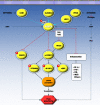Metformin: A Prospective Alternative for the Treatment of Chronic Pain
- PMID: 33178015
- PMCID: PMC7538784
- DOI: 10.3389/fphar.2020.558474
Metformin: A Prospective Alternative for the Treatment of Chronic Pain
Abstract
Metformin (biguanide) is a drug widely used for the treatment of type 2 diabetes. This drug has been used for 60 years as a highly effective antihyperglycemic agent. The search for the mechanism of action of metformin has produced an enormous amount of research to explain its effects on gluconeogenesis, protein metabolism, fatty acid oxidation, oxidative stress, glucose uptake, autophagy and pain, among others. It was only up the end of the 1990s and beginning of this century that some of its mechanisms were revealed. Metformin induces its beneficial effects in diabetes through the activation of a master switch kinase named AMP-activated protein kinase (AMPK). Two upstream kinases account for the physiological activation of AMPK: liver kinase B1 and calcium/calmodulin-dependent protein kinase kinase 2. Once activated, AMPK inhibits the mechanistic target of rapamycin complex 1 (mTORC1), which in turn avoids the phosphorylation of p70 ribosomal protein S6 kinase 1 and phosphatidylinositol 3-kinase/protein kinase B signaling pathways and reduces cap-dependent translation initiation. Since metformin is a disease-modifying drug in type 2 diabetes, which reduces the mTORC1 signaling to induce its effects on neuronal plasticity, it was proposed that these mechanisms could also explain the antinociceptive effect of this drug in several models of chronic pain. These studies have highlighted the efficacy of this drug in chronic pain, such as that from neuropathy, insulin resistance, diabetic neuropathy, and fibromyalgia-type pain. Mounting evidence indicates that chronic pain may induce anxiety, depression and cognitive impairment in rodents and humans. Interestingly, metformin is able to reverse some of these consequences of pathological pain in rodents. The purpose of this review was to analyze the current evidence about the effects of metformin in chronic pain and three of its comorbidities (anxiety, depression and cognitive impairment).
Keywords: AMPK activation; anxiety; chronic pain; depression; diabetes; diabetic neuropathy; metformin; neuropathic pain.
Copyright © 2020 Baeza-Flores, Guzmán-Priego, Parra-Flores, Murbartián, Torres-López and Granados-Soto.
Figures

References
-
- Acosta-Cota S. J., Aguilar-Medina E. M., Ramos-Payán R., Rendón-Maldonado J. G., Romero-Quintana J. G., Montes-Avila J., et al. (2019). Therapeutic effect of treatment with metformin and/or 4-hydroxychalcone in male Wistar rats with nonalcoholic fatty liver disease. Eur. J. Pharmacol. 863, 172699. 10.1016/j.ejphar.2019.172699 - DOI - PubMed
-
- Afshari K., Dehdashtian A., Haddadi N. S., Haj-Mirzaian A., Iranmehr A., Ebrahimi M. A., et al. (2018). Anti-inflammatory effects of metformin improve the neuropathic pain and locomotor activity in spinal cord injured rats: introduction of an alternative therapy. Spinal Cord 56 (11), 1032–1041. 10.1038/s41393-018-0168-x - DOI - PubMed
-
- Alcocer-Gómez E., Garrido-Maraver J., Bullón P., Marín-Aguilar F., Cotán D., Carrión A. M., et al. (2015). Metformin and caloric restriction induce an AMPK-dependent restoration of mitochondrial dysfunction in fibroblasts from fibromyalgia patients. Biochem. Biophys. Acta 1852 (7), 1257–1267. 10.1016/j.bbadis.2015.03.005 - DOI - PubMed
-
- Andre C., Dinel A. L., Ferreira G., Laye S., Castanon N. (2014). Diet-induced obesity progressively alters cognition, anxiety-like behavior and lipopolysaccharide-induced depressive-like behavior: focus on brain indoleamine 2, 3-dioxygenase activation. Brain Behav. Immun. 41, 10–21. 10.1016/j.bbi.2014.03.012 - DOI - PubMed
Publication types
LinkOut - more resources
Full Text Sources
Miscellaneous

